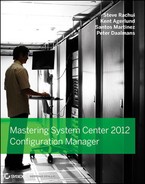Book Description
Expert coverage of Microsoft's highly anticipated network software deployment tool
The latest version of System Center Configuration Manager (ConfigMgr) is a dramatic update of its predecessor Configuration Manager 2007, and this book offers intermediate-to-advanced coverage of how the new ConfigMgr boasts a simplified hierarchy, role-based security, a new console, flexible application deployment, and mobile management. You'll explore planning and installation, migrating from ConfigMgr 2007, deploying software and operating systems, security, monitoring and troubleshooting, and automating and customizing ConfigMgr 2012 with scripts.
Features an unparalleled team of authors, two of whom are insiders at Microsoft and have worked with ConfigMgr since nearly its inception
Provides in-depth coverage and offers a hands-on approach to learning all there is to know about ConfigMgr
Explores why ConfigMgr 2012 is the most significant update in its 16-year history
Packed with real-world scenarios to show you how to use ConfigMgr in various contexts, Mastering System Center 2012 Configuration Manager covers all aspects of this powerful and complete network software deployment tool.
Table of Contents
- Cover
- Contents
- Title
- Copyright
- Dedication
- Acknowledgments
- About the Authors
- About the Contributing Author
- Introduction
- Chapter 1: Overview of Operations Management
- Chapter 2: Planning a Configuration Manager Infrastructure
- Chapter 3: Migrating from Configuration Manager 2007
- Chapter 4: Installation and Site Role Configuration
- Chapter 5: Role-Based Administration
- Chapter 6: Client Installation
- Chapter 7: Application Deployment
- Chapter 8: Software Updates
- What’s New in Software Updates
- Prerequisites for Software Updates
- Elements of Software Updates
- The Software Update Process in Configuration Manager
- Planning to Use Software Updates in Configuration Manager
- Configuring Software Updates
- Preparing Software Updates for Deployment
- Deploying Software Updates with the Deploy Software Updates Wizard
- Using System Center Updates Publisher
- Monitoring Software Update Deployments
- The Bottom Line
- Chapter 9: Operating System Deployment
- What’s New in Operating System Deployment
- Planning for OSD with Configuration Manager 2012
- Deployment Process
- Preparing Configuration Manager 2012 for Operating System Deployment
- Adding Operating System Installers
- Developing a Task Sequence for Creating a Capture Image
- Capturing an Operating System Image
- Deploying an Image
- Deploying the Operating System on Bare Metal
- Installing Device Drivers into OSD
- Servicing Your Operating System Images Offline
- Using User Device Affinity
- Microsoft Deployment Toolkit 2012
- Maintaining the User State
- The Bottom Line
- Chapter 10: Asset Intelligence
- Chapter 11: Inventory and Software Metering
- Chapter 12: Reporting
- Chapter 13: Compliance Settings
- Chapter 14: Mobile Device Management
- Chapter 15: Troubleshooting
- Chapter 16: Disaster Recovery
- Chapter 17: System Center Endpoint Protection
- Chapter 18: Client Health
- Appendix: The Bottom Line
- Index
